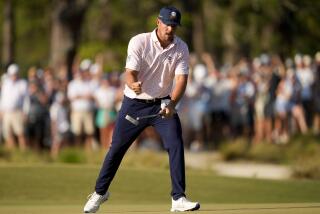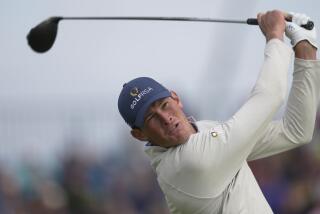Course plays long on legend
- Share via
OAKMONT, PA. — Maybe it’s because of the Church Pews. Those rows of bunkers between the third and fourth holes are probably one reason Oakmont Country Club is spoken about in such reverential terms. Or maybe it’s all about Oakmont’s long and colorful history of playing host to major championships, 10 in all -- seven U.S. Opens and three PGA Championships -- dating back 85 years.
It could be all the great champions, a Hall of Fame list if there ever was one. That might explain why Oakmont deserves its star treatment.
This week, the U.S. Open returns to Oakmont for the first time in 13 years, and the venerable layout appears capable of producing another legendary tournament and champion to go along with it.
Tiger Woods, if he can keep the ball on the fairway, and Phil Mickelson, if he can keep from re-injuring his wrist, remain the favorites at the 7,230-yard course in suburban Pittsburgh.
But before we go forward, it’s worth looking back at the best that Oakmont has offered, a stirring succession of major-championship golf and history in the making.
1922 PGA Championship
Eugene Sarazen of Harrison, N.Y., was well known as Gene, but when he defeated Emmett French, 4 and 3, in the final match, he became known as something else -- the first player to hold the U.S. Open and PGA Championship titles at the same time. Sarazen had won the Open earlier in the year at Skokie Country Club by one shot over Bobby Jones and John Black.
And Sarazen was only 20. The 5-foot-5 1/2 , 162-pounder was Italian and came from a poor family. A former caddie, Sarazen was just getting started on his Hall of Fame career and he went on to win seven major titles.
He also launched the Masters into prime time with his famous double eagle in 1935, the same year he won his only title at Augusta. Sarazen is given credit for being the first to develop the sand wedge.
Footnote: Leading into the tournament, the major talk was that Walter Hagen, the defending champion, wasn’t coming back because he was busy playing exhibitions.
1927 U.S. Open
The first Open played at Oakmont turned out to be good news for Tommy Armour, who is also the last Scotsman to win the Open. Armour might also be the last one-eyed player to win -- he was blind in one eye because of a mustard gas injury in World War I.
Armour won in a playoff over Harry “Lighthorse” Cooper.
But first, Armour had to get into the playoff and he needed to birdie the last hole of regulation to do it. As Armour stood in the last fairway, someone in the gallery called to him.
“I’ve been reading that you’re a great iron player; well, let’s see you hit one now,” the spectator said.
Armour hit a three-iron to 10 feet of the hole.
“Will that do?” said Armour, who made his birdie.
Footnotes: This 31st U.S. Open was also notable on a couple of other fronts. Bobby Jones tied for 11th -- the only time he was out of the top 10 in his 11 trips to the U.S. Open. Also, Johnny Farrell won $1,000 from a clothing manufacturer for being the best-dressed golfer -- $300 more than Armour’s prize money for winning.
1935 U.S. Open
He shot 11 over and closed with a 76, but Sam Parks still managed to win, by two shots over Jimmy Thomson and three over Hagen.
Any one of 10 players besides Parks could have won with a good final round -- Thompson, Ray Mangrum, Hagen, Alvin Krueger, Denny Shute, Sarazen, Henry Picard, Dick Metz, Vincent Eldred and Al Espinosa -- but no one in that group could do better than the 76 by Hagen and Shute.
Hagen briefly led with birdies at the first and fourth on the last day and he made the turn in 37. But at 42, Hagen seemed to wear out. He made four consecutive bogeys to start the back nine.
As it turned out, it was the last time Hagen would lead in a major championship. He played in only two more U.S. Opens.
Footnote: Byron Nelson, 23, tied for 32nd. He would win his first major title at the 1937 Masters.
1951 PGA Championship
Sam Snead won his third and last PGA Championship on his way to seven major championship titles.
Snead trounced Walter Burkemo in the final, 7 and 6, but he almost never made it that far. Snead beat Fred Haas Jr., 1-up, in the first round in the morning and defeated Marty Furgol in 21 holes in a contentious match in the afternoon.
With the match all square at the 14th hole, Snead leaned over his golf ball and waved at an insect that had landed on top, then blew on it and tried to get it to move. Furgol protested that Snead had cleaned his ball and a rules official was summoned. Snead had done nothing wrong, the official said, but Furgol insisted the rules committee get involved.
After 18 holes, the match was still all square. Furgol went to the clubhouse to wait for the committee’s decision and Snead went to the first tee, where he waited for 30 minutes before Furgol announced he was withdrawing his protest.
Snead made a birdie at the 21st hole to win it.
Footnote: Only one PGA Championship ended in a more one-sided final: In 1938, Paul Runyan coasted to an 8 and 7 victory ... over Snead.
1953 U.S. Open
Snead became an Open runner-up for the fourth time, losing by six shots to Ben Hogan, who won the third of his four U.S. Open titles. Nothing unusual there, since Hogan all but owned the Open.
But what was unusual about this championship wasn’t the fact that Hogan won, it was that he nearly missed playing at all. The USGA instituted a different format for entry, increasing the number of sectional qualifiers from 162 to 300, and those 300 played 36 holes at Oakmont and Pittsburgh Field Club the two days before the tournament. The 149 players with the lowest scores got in, along with defending champion Julius Boros.
Hogan shot a 77 the first day of qualifying, but his 73 the second day earned him a spot.
Footnote: A 24-year-old amateur from Latrobe named Arnold Palmer made his first U.S. Open field as an alternate. He missed the cut.
1962 U.S. Open
Palmer was a runner-up at the U.S. Open four times, but this one might have hurt the most, losing by three shots to 22-year-old Jack Nicklaus in an 18-hole playoff.
Palmer led Nicklaus by two shots after 54 holes, but Nicklaus closed with a 69 and caught Palmer at one-under 283. Of course, there’s nothing shameful about losing to Nicklaus, but Palmer wanted to come through in front of what amounted to his hometown fans.
It might have been different, but Palmer couldn’t close the deal. He eagled the 17th hole in regulation but missed a short par putt at the 18th hole after he had backed away from it because he was bothered by the noise from an airplane.
Nicklaus was just taking off in his career. This was the first of his 18 major titles.
Footnote: Hogan was not exempt from qualifying for the first time since 1940. Hogan sent in his application but withdrew on the day of qualifying because of bursitis in his shoulder.
1973 U.S. Open
At the Masters in April, Johnny Miller tied for sixth and showed flashes of what was in store at Oakmont. Still on his mind was the final-round 79 Miller shot the year before in the U.S. Open at Pebble Beach, his favorite course.
The outcome this time wasn’t anything like that. Miller’s eight-under 63 set a final-round Open scoring record that has never been beaten.
Miller, six shots off the lead and tied for 13th when the final round began, beat John Schlee by one shot. Miller went on to win 25 PGA Tour events, eight in 1974. He won one more major, the 1976 British Open at Royal Birkdale, by six shots.
Footnote: Tom Watson, who finished third, dismissed the notion that overnight rains had softened the greens and made the course much easier for Miller’s exceptional finish. He said, “Johnny could run the tables, and that’s what he did.”
1978 PGA Championship
John Mahaffey’s previous claim to fame, besides being a two-time All-American at the University of Houston, was that he played a practice round with Hogan in 1971 and that earned him a special invitation to play in Hogan’s Colonial Invitational the same year. He finished 12th.
Mahaffey won the 1973 Sahara Invitational but didn’t break through until this four-day excursion around Oakmont and a victory on the second hole of a playoff with Watson and Jerry Pate.
Trailing third-round leader Watson by seven shots, Mahaffey set a PGA Championship record with his comeback. Mahaffey’s closing 66 was punctuated by a 12-foot birdie putt on the 18th hole.
Mahaffey went on to win eight more PGA Tour events, including the 1986 Players.
Footnote: This event was the eighth major played at Oakmont, making it the most-used U.S. course for major championships after Augusta National.
1983 U.S. Open
Larry Nelson wound up winning his second major title, to go along with his 1981 PGA Championship victory, but the week didn’t start off so well. The airline lost his golf clubs. Nelson didn’t get them until nearly 9 p.m. on Tuesday, at which time Nelson decided to practice putting in the dark.
It must have worked pretty well, although once again, it didn’t look like it from the beginning. Nelson shot a 74 in the first round and was tied for 40th. He shot a second-round 73 and made the cut by three shots. When he bogeyed the third hole in the third round, he was seven over for the week.
But after he made par at the fourth, Nelson played the next 13 holes in seven under, finished with a 65 and passed 20 players. Just a shot behind leaders Watson and Seve Ballesteros, Nelson was even with Watson when a storm hit Oakmont and postponed the last three holes until Monday morning.
Then, Nelson made a 65-foot putt for birdie at the 16th to take the lead, end with a 67 and beat Watson, who shot 69, by one shot.
Footnote: In time for the last hole in the fourth round, Forrest Fezler became the first player in U.S. Open history to wear shorts. He used a portable toilet for his changing room after the 17th hole, made a bogey for a 75, then changed back into slacks in the clubhouse.
1994 U.S. Open
The first of Ernie Els’ two U.S. Open titles arrived after he withstood the rigors of a playoff with Colin Montgomerie and Loren Roberts. He beat Roberts with a par on the second extra hole after they each shot 74 in an 18-hole playoff, with Montgomerie falling out after his 78.
Besides being blisteringly hot, this Open was unusual for the winner receiving two unlikely “drops” in the fourth round.
He got one free drop after hooking his drive into the rough at the first hole when USGA official Trey Holland mistakenly ruled that a TV camera atop a crane was immovable, despite the fact it had wheels. Els still made a bogey. The second break Els received was on the 17th after he drove behind a grandstand. He was allowed to use the drop circle, even though the ruling actually allowed his ball to be closer to the hole. Els made par.
Footnote: Palmer, 64, played his 32nd and final U.S. Open, thus becoming the only player to compete in five U.S. Opens on the same course.
--
(BEGIN TEXT OF INFOBOX)
Historic site
Significant events at Oakmont (Pa.) Country Club, site of this year’s U.S. Open (Thursday-Sunday):
YEAR; EVENT; WINNER
1919; U.S. Amateur; S. Davidson Herron def. Bobby Jones, 5 and 4
1922; PGA Championship; Gene Sarazen def. Emmett French, 4 and 3
1925; U.S. Amateur; Bobby Jones def. Watts Gunn, 8 and 7
1927; U.S. Open; Tommy Armour (playoff over Harry Cooper)
1935; U.S. Open; Sam Parks (two shots over Jimmy Thomson)
1938; U.S. Amateur; William Turnesa def. B. Patrick Abbott, 8 and 7
1951 ; PGA Championship; Sam Snead def. Walter Burkemo, 7 and 6
1953 ; U.S. Open; Ben Hogan (six shots over Sam Snead)
1962; U.S. Open; Jack Nicklaus (playoff over Arnold Palmer)
1969 ; U.S. Amateur; Steve Melnyk (five shots over Marvin Giles)
1973 ; U.S. Open; Johnny Miller (one shot over John Schlee)
1978; PGA Championship; John Mahaffey (playoff over Tom Watson, Jerry Pate)
1983; U.S. Open; Larry Nelson (one shot over Tom Watson)
1992; U.S. Women’s Open; Patty Sheehan (playoff over Juli Inkster)
1994 ; U.S. Open; Ernie Els (playoff over Loren Roberts, Colin Montgomerie)
2003; U.S. Amateur; Nick Flanagan (37 holes over Casey Wittenberg)
More to Read
Go beyond the scoreboard
Get the latest on L.A.'s teams in the daily Sports Report newsletter.
You may occasionally receive promotional content from the Los Angeles Times.










